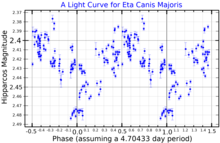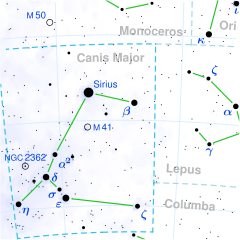Eta Canis Majoris
| Observation data Epoch J2000 Equinox J2000 | |
|---|---|
| Constellation | Canis Major |
| Right ascension | 07h 24m 05.70228s[1] |
| Declination | –29° 18′ 11.1798″[1] |
| Apparent magnitude (V) | 2.450[2] |
| Characteristics | |
| Spectral type | B5 Ia[3] |
| U−B color index | −0.708[2] |
| B−V color index | −0.087[2] |
| Variable type | α Cyg[4] |
| Absolute magnitude (MV) | −7.0[6] |
| Details | |
Myr | |
| 173651 | |
| Database references | |
| SIMBAD | data |
Eta Canis Majoris (η Canis Majoris, abbreviated Eta CMa, η CMa), also named Aludra
Nomenclature
η Canis Majoris (Latinised to Eta Canis Majoris) is the star's Bayer designation.
The traditional name Aludra originates from the
In
Properties

A blue-white
Eta CMa shines brightly in the skies in spite of a large distance from Earth due to being intrinsically many times brighter than the Sun. It has a luminosity over 100,000 times and a radius around 54 times that of the Sun. It has only been around a fraction of the time the Sun has, less than 10 million years, yet is already in the last stages of its life. It is still expanding and may become a red supergiant, or perhaps has already passed that phase, but in either case it will become a supernova within the next few million years.[citation needed]
Eta CMa is classified as an Alpha Cygni-type variable star and its brightness varies from magnitude +2.38 to +2.48 over a period of 4.7 days.[4][19]
Namesakes
Both
References
- ^ S2CID 18759600.
- ^ doi:10.1086/150019
- S2CID 59151633
- ^ Bibcode:1999IBVS.4659....1K.
- Bibcode:1999VeARI..35....1W
- S2CID 237605138.
- ^ S2CID 126150688.
- S2CID 118629873.
- ^ "IAU Catalog of Star Names". Retrieved 28 July 2016.
- Bibcode:1993AAS...183.1710G, archived from the originalon 2019-06-25, retrieved 2012-02-04
- ISBN 0-486-21079-0, retrieved 2010-12-12
- ^ "IAU Working Group on Star Names (WGSN)". Retrieved 22 May 2016.
- ^ "Bulletin of the IAU Working Group on Star Names, No. 1" (PDF). Retrieved 28 July 2016.
- ^ 弧矢 (Hú Shǐ) is westernized into Koo She. R.H. Allen had opinion that Koo She refers to the asterism including Delta Velorum and Omega Velorum. AEEA opinion is, Delta Velorum is member of 天社 (Tiān Shè), meaning Celestial Earth God's Temple asterism, and Omega Velorum is not member of any asterisms. 天社 (Tiān Shè) is westernized into Tseen She and R.H. Allen used the term Tseen She for Chinese name of Eta Carinae. See Richard Hinckley Allen: Star Names — Their Lore and Meaning: Argo Navis and (in Chinese) AEEA (Activities of Exhibition and Education in Astronomy) 天文教育資訊網 2006 年 7 月 17 日 Archived 2012-02-04 at the Wayback Machine.
- ^ (in Chinese) AEEA (Activities of Exhibition and Education in Astronomy) 天文教育資訊網 2006 年 7 月 17 日 Archived 2012-02-04 at the Wayback Machine
- ^ "Light Curve". Hipparcos ESA. ESA. Retrieved 12 August 2022.
- Bibcode:1978rmsa.book.....M.)
{{cite book}}: CS1 maint: location missing publisher (link - ^ Watson, Christopher (3 May 2013). "Eta Canis Majoris". AAVSO Website. American Association of Variable Star Observers. Retrieved 5 February 2014.

